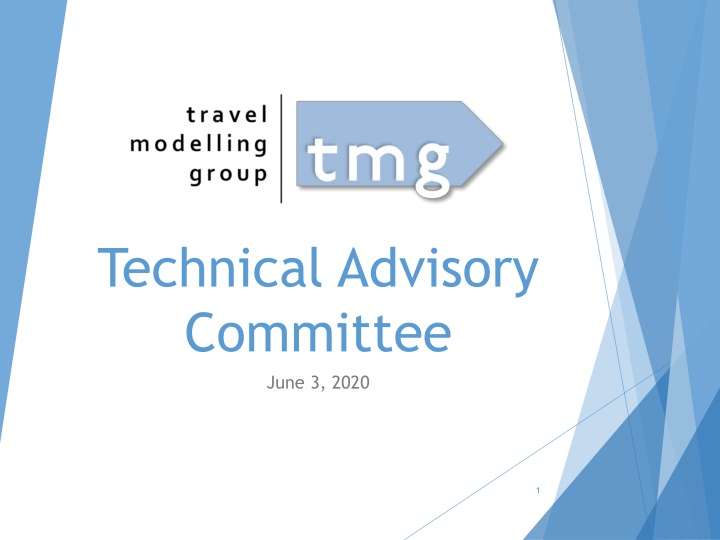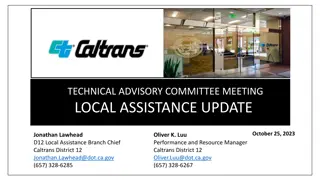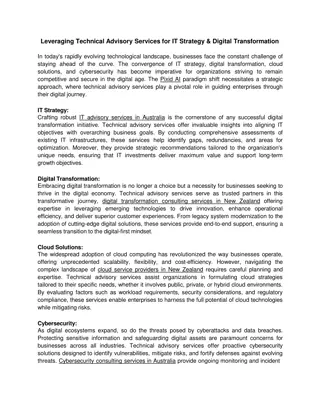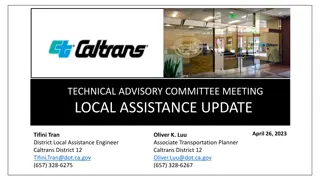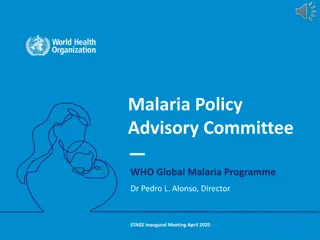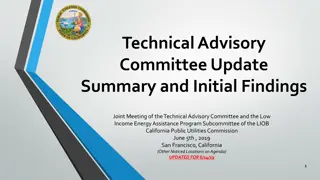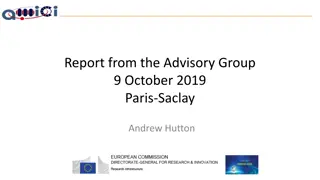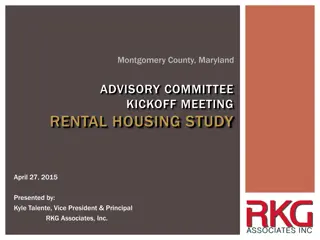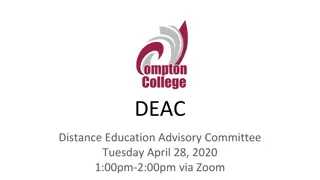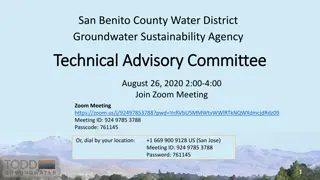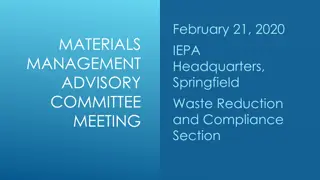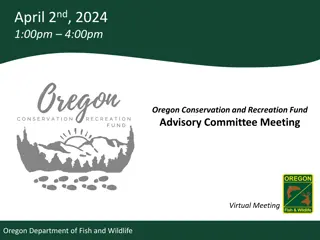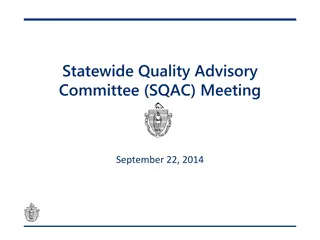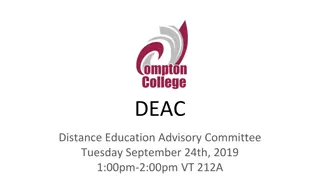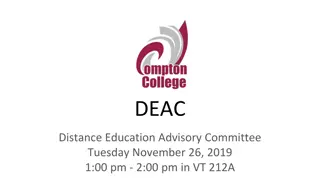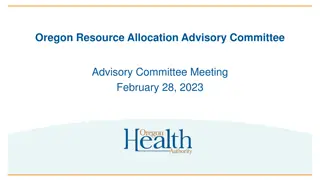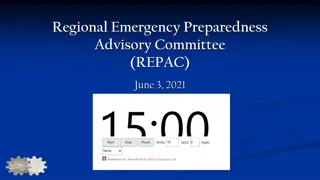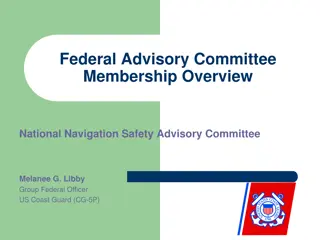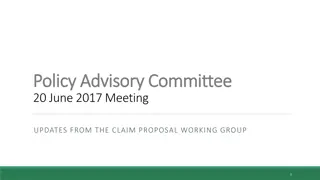Technical Advisory Committee Meeting Overview
: This document provides insights into the recent Technical Advisory Committee meeting held on June 3, 2020. It includes updates on the work plan, models, COVID-19 activities, and more. Details on the tasks, time allocation, and forthcoming steps are outlined. Data availability, model calibration, and living arrangement analysis are discussed, offering a comprehensive view of the committee's agenda and plans.
Download Presentation

Please find below an Image/Link to download the presentation.
The content on the website is provided AS IS for your information and personal use only. It may not be sold, licensed, or shared on other websites without obtaining consent from the author.If you encounter any issues during the download, it is possible that the publisher has removed the file from their server.
You are allowed to download the files provided on this website for personal or commercial use, subject to the condition that they are used lawfully. All files are the property of their respective owners.
The content on the website is provided AS IS for your information and personal use only. It may not be sold, licensed, or shared on other websites without obtaining consent from the author.
E N D
Presentation Transcript
Technical Advisory Committee June 3, 2020 1
Agenda Work plan update: Place of Residence Place of School Modelling. Transit Cost Modelling. Aimsun COVID-19: Possible TMG Activities (general discussion) Other business. Adjournment. 2
2020-21 Work Plan TMG 2020-21 Work Plan MONTH Days Allocated Total1 No. TASK 1 Large-Scale Model System Calibration Guidance 2 Large-Scale Model System Convergence Testing & Guidance 3 Volume-Delay Function (VDF) Evaluation & Calibration 4 PORPOS Modelling2 5 PORPOW Modelling Apr May June July Aug Sep Oct Nov Dec Jan Feb Mar % 3 3 3 1 40 7.6% 2 3 3 3 44 8.3% 3 3 3 3 3 60 11.4% 2 2 2 2 2 2 48 9.1% 2 2 2 2 2 2 48 9.1% 3 6 Traffic Zone System Update 7 GTAModel Maintenance & V4.2 Release 8 TMG Aimsun & Emme Toolbox Development & Maintenance 9 XTMF: Upgrades/ Maintenance & V2.0 Release 10 Documentation of TMG products 11 Outreach & Training (3 workshops) 12 Meetings: TMGSC (2) & TMGTAC (5) TMG Staff Average Weekly Time Allocation (Days)4 0 0.0% 2 2 2 2 2 2 2 2 2 2 2 2 96 18.2% 1 1 1 1 1 1 2 2 2 2 2 2 72 13.6% 2 2 2 2 2 2 1 1 1 1 1 1 72 13.6% 1 1 1 1 1 1 1 1 1 1 1 1 48 9.1% W1 W2 W3 528 Total TAC TAC TAC SC TAC TAC SC 11 11 11 11 11 11 11 11 11 11 11 11 11.0 3
PoRPoS Model Place of Residence Place of School Ethan Baron, Gonzalo Martinez Santos 4
Data Available 2016 TTS, 2015/2019 StudentMoveTO (SMTO) surveys SMTO TTS Post-secondary students only Balanced representation of student population (living arrangement, mode choice, etc.) Not post-secondary specific requires filtering Household survey might be biased towards certain living arrangements, etc. No specific information on living arrangement Filtering TTS: Ex. Filtered 17-year-old secondary students (remove students whose school zone attracts primarily 17-year-olds). Analyzing Travel Times/Distances: We found a significant number of unrealistic cases (ex. Long walking distances in short periods of time) More filtering required 2015 vs 2019 SMTO Similarities Improvements Consequences 2015 SMTO Distance vs Time for Walkers Similar demographic distributions Respondent and household characteristics 26% sample size increase More schools represented Colleges included Additional mode information Better representation of student travel across GTHA Different mode choice distributions due to larger geographical sample
% of Students Living with Family/Parents Results So Far SMTO 56.5% TTS 68.8% Living arrangement classification Machine learning: does student live with family/parents? Trained on 2015 SMTO to run on TTS Group UG FT F UG FT O UG PT O FT F O FT O O PT ????? -0.067 -0.172 -0.076 -0.054 -0.103 -0.075 ? Simple location choice model (2015 SMTO) 6842 3334 689 973 2412 339 ???= ??+ ??????? Significant differences by level (Undergrad/Other), status (Full-time/ Part-time), living arrangement (family/other) Next Steps More accurate location choice model Include better measure of accessibility (mode choice model?), consider further characteristics 6 Analyze 2019 SMTO data and compare results
Transit Cost Modelling (Peter Lai) We are building transit operating and capital cost models for implementation in GTAModel. Will be implemented as Emme modules. The big challenge is getting detailed data. 7
Updates on Aimsun Traffic Static assignment Dynamic simulation Pedestrian Transit Network converter 8
Static Road Assignment Network Imported from Emme Remove the links with no auto access, as well as the affected nodes and centroid connectors Change the VDFs on centroid connectors to be consistent with Emme Use 1hr demand for tests and comparison Intra-zonal trips are ignored by Aimsun 9
Run time Convergence issue is under investigation Assignment Run Time Settings: SOLA 1m No background transit Emme Standard 1m 30s Max iteration: 80 Relative gap: 0.01 All-or-nothing 1m 17s Best relative gap: 0 Incremental 1m 29s Aimsun Normalized gap: 0 MSA 8m 19s Frank & Wolfe 11m 13s 10
Average AIVTT difference (Emme Aimsun) Toronto Durham York Peel Halton Hamilton Toronto -5.79 -0.90 -1.21 -1.17 -1.12 -1.15 Durham -10.02 -0.35 -1.04 -3.58 -3.94 -4.00 York -10.28 -0.95 -1.53 -3.07 -3.23 -3.32 Peel -9.93 -2.97 -2.11 -1.97 -1.40 -1.59 Halton -9.14 -3.27 -2.77 -2.00 -0.33 -0.09 Hamilton -8.44 -1.92 -1.47 -0.82 0.23 -0.02 12
DUE Simulation No more crashes with the new network Test setting Same network as used in the static assignment AM peak 6am to 7am (1hr demand) 20 iterations and 1% relative gap 15min cycle Run time 59 min (stopped at the max iteration) 15
Pedestrian Simulation Dynamic microsimulation only Walking is not allowed on street (i.e., on road sections/links) Simulation is restricted within the pedestrian area 16
Pedestrian Simulation Contd Walk-all-way trips are allowed only if two centroids are connected to the same transit stop Walking + Transit Within the pedestrian area Need in and out centroids at a bus stop 17
Transit Network Issue When importing GTFS data, the transit stops are placed at the positions based on the coordinates only one transit stop is added But Aimsun sections cannot share stops A converter is under development To convert the GTAModel transit network from Emme to Aimsun easily and correctly. This tool will correct the coordinates of the stops at intersections/nodes & add stops if needed Current progress 18
Transit Assignment Should be able to replicate the implementation of STSU and fare scheme Boarding cost, distance-based cost, and zone cost Number of boarding/alighting at stops User-specified speed of transit vehicles 19
COVID-19: TMG Response? We have submitted a research proposal to the NSERC Alliance COVID-19 Grant program: COVID-19 Impacts on Urban Travel and Activity Patterns Employing Cellphone Travel Data Will be using detailed TELUS cellphone traces to explore changes in travel patterns pre-, during and post- lockdown. Will be using TTS & GTAModel data to train machine learning models to impute traces trip mode & activity purpose. We are also talking with RBC about augmenting the TELUS data with credit/debit card transaction data. TISC is considering a fall travel survey to benchmark travel behaviour as of fall, 2020. Ideally, a spring 2021 survey should also be undertaken. Can compare observed behaviour to business as usual behaviour as captured in the 2016 GTAModel 4.1 / 4.2. 20
COVID-19 & TMG, 2 Should we be revising the workplan to more directly address COVID-19 impacts and recovery planning? Perhaps invest TMG resources in the NSERC project? Another possibility: Gather together as much traffic and transit count data as possible. Assemble 2020 population, employment and transportation network scenario. Run GTAModel for 2020 pre-COVID conditions. Compare GTAModel results with observed counts. Work backwards , subtracting trips / trip-makers until the model reproduces ( reasonably well ) observed counts. Would need to think about how to systematically do this. Other suggestions? 21
Meeting Schedule All meetings will be virtual (on Microsoft Teams) until further notice. TMG Technical Advisory Committee Meetings: Wednesday, August 5, 10:00-12:00 Wednesday, November 4, 10:00-12:00 Wednesday, January 13, 2021, 10:00-12:00 TMG Steering Committee Meetings: Wednesday, October 7, 10:00-12:00 Wednesday, March 3, 2021 Workshops: Wednesday, September 9, 9:00-12:00 Wednesday, December 2, 9:00-12:00 Wednesday, February 3, 2021, 9:00-12:00 22
